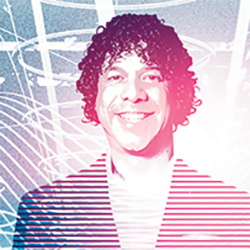|
REGISTRATION REQUIRED
exhibitor q&a
Help!
Lighting and Staging
 Q.
I know lighting is important to exhibit design, but I'm not exactly sure how best to use it. Can you provide some ammunition to help me make a case for it with management, and give me some tips for creating an effective lighting design?A.
Exhibit lighting and staging are critical components of any successful program, but often, they're difficult line items to justify to management. Typical procurement agents argue that even without proper lighting, your properties, messages, and demonstrations are still clearly visible to attendees. So why bother, right? What many people don't realize, however, is that lighting actually does far more than illuminate a space. It adds drama, sets the mood, generates attention, directs traffic, delivers messaging, and more. In fact, in the exhibition world, theatrical lighting is probably the one element beyond graphics that provides the greatest impact on how the branded experience is delivered. The manner in which an environment is lit can make all the difference in the level of success achieved at an event. If you're having a hard time proving this fact to management, try this little trick. Have your exhibit designer create a beautiful conceptual rendering of your booth with proper lighting. Then, have the designer remove the lighting, and maybe depict your structure alongside other exhibits with proper lighting plans. Presenting those images side by side will be an eye-opening experience for those who undervalue lighting and staging. Applications To help you better understand how to use light within your space, here's a brief overview of some of the most important things proper lighting can do for your booth. ► Establish a mood. While exhibitry provides a framework for the attendee experience, lighting sets the mood by adding drama, warmth, energy, etc. For example, an exhibit for an automotive manufacturer might include various car models and some interactive kiosks. But if you add a changing color wash and moving light fixtures, you have just incorporated dynamic energy in the space. Along these same lines, soft, warm hues create a feeling of comfort and relaxation while bright white light provides a high-tech or industrial feel. ► Focus attention and drive traffic. A space devoid of light fixtures is a relatively neutral canvas that relies on graphics and perhaps splashes of color to capture attendees' eyes. With proper lighting, however, you can direct attendees' gaze to specific areas within the exhibit – making a product or display area pop out of your neutral canvas. Similarly, in larger exhibits, lighting can be used to actually direct traffic to various areas of your space. By illuminating some areas more than others or moving fixtures back and forth to create a sense of movement and direction, you can point booth visitors where you want them to go. ► Create consistency. One of the most overlooked yet most powerful roles that lighting can play is to create consistency across multiple exhibits, perhaps of varying sizes. Let's say you have an 80-by-80-foot booth and a 20-by-20-foot exhibit. By using the same general lighting-design elements (e.g., similar colors, tones, movement, etc.) you can create brand consistency so that the overall experience is similar – and often instantly recognizable – in all your exhibits. Guidelines Just as with any exhibit-design element, success on the back end hinges on your planning on the front end. So to ensure that your lighting and staging plan is effective, here are some critical guidelines to consider as you map out your lighting design. ► Set goals. As with almost every element of your exhibiting strategy, you need a specific goal or objective before you start the design process. What must your lighting design to do? Should it create a mood, reinforce brand attributes, focus attention on specific display areas, highlight an ID tower, etc.? Be sure you've established a clear purpose for your lighting before you start washing your space with indiscriminate light. ► Consider barriers. Along these same lines, consider the parameters and barriers you're facing at each show. For example, are there specific brand-color guidelines to which your lighting must adhere? Or are there unique line-of-sight challenges at a specific show due, perhaps, to a convention-center column or another exhibitor with a towering structure between your space and the main entrance? And don't forget about ambient lighting. Often, you'll need to create a plan that includes adding light to your presence but also detracting or shielding existing light that can negatively affect your strategy. ► Don't layer it on top. Rather than crafting an exhibit design and then adding the lighting like a layer of cake frosting, make your lighting strategy an integral part of the overall design. Doing so will certainly help create a cohesive brand experience, but it could also save you a significant amount of cash. For example, instead of creating rigging just for your light fixtures, that same overhead structure could be used to support hanging signs, audiovisual components, or products. And using one structure instead of two decreases the costs of exhibitry, transportation, drayage, and labor required to install it. Plus, if you don't work lighting demands into the design early, you could be dealing with major redesign issues – with regard to both lighting elements and exhibitry – down the road. For example, light-fixture positioning may necessitate the movement of various exhibit structures, or vice versa. ► Figure in operational space. Many lighting designs require at least a small operational space within your exhibit footprint, along with a technician or two to keep things running smoothly. For example, you might simply need an electrical-control room where a technician can turn lights on and off at the beginning and end of the day. Or, your setup could require two technicians on hand at all times to monitor and maneuver your digital-lighting controls, perhaps to highlight different booth activities (e.g., press events, presentations, product demos, etc.) throughout the day. So include these elements in your overall exhibit design as opposed to trying to cram them in after the fact. ► Create a mockup. Allocate resources and time for a physical mockup to preview different lighting effects and the impact that they will have on your chosen materials. For example, how is a blue color wash actually going to look when your canvas is a green metallic scrim? Or will there be considerable glare if your exhibit is filled with glossy laminate? By trying out your lighting plan on the various surfaces within your exhibit, you'll often discover minor issues that can be easily tackled before the show. This is a far better plan than trying to come up with a last-minute fix during setup. As you can see, lighting provides far more than illumination for your exhibit space. The key, however, is to have clear objectives and to integrate your lighting plan into your overall design strategy. When paired with a successful exhibit design, lighting can provide everything from simple illumination and product focus to down-home warmth and theatrical drama.
E — Darrin Jackson, director of creative services, Dimension Design, Glenview, IL
Help Wanted Send your tough questions about exhibiting to Linda Armstrong, larmstrong@exhibitormagazine.com.
|
|
|
||||||||||||||||||||||||||||
|
|
||||||||||||||||||||||||||||
|
TOPICS Measurement & Budgeting Planning & Execution Marketing & Promotion Events & Venues Personal & Career Exhibits & Experiences International Exhibiting Resources for Rookies Research & Resources |
MAGAZINE Subscribe Today! Renew Subscription Update Address Digital Downloads Newsletters Advertise |
FIND IT Exhibit Producers Products & Services All Companies Get Listed |
EXHIBITORLIVE Sessions Exhibit Hall Exhibit at the Show Registration |
ETRAK Sessions Certification F.A.Q. Registration |
EDUCATION WEEK Overview Sessions Hotel Registration |
CERTIFICATION The Program Steps to Certification Faculty and Staff Enroll in CTSM Submit Quiz Answers My CTSM |
AWARDS Exhibit Design Awards Portable/Modular Awards Corporate Event Awards Centers of Excellence |
NEWS Associations/Press Awards Company News International New Products People Shows & Events Venues & Destinations EXHIBITOR News |
||||||||||||||||||||
|
||||||||||||||||||||||||||||






